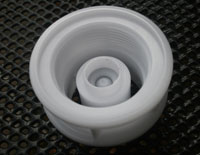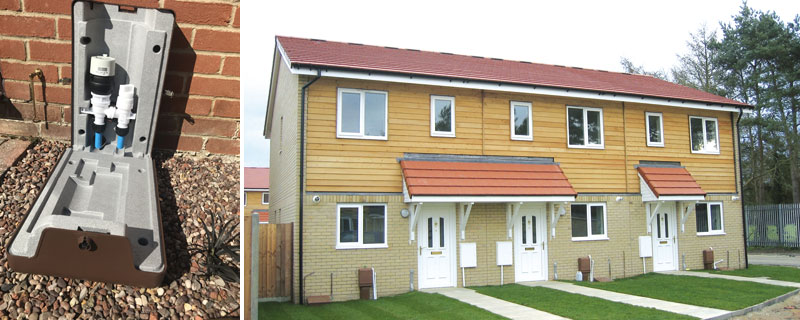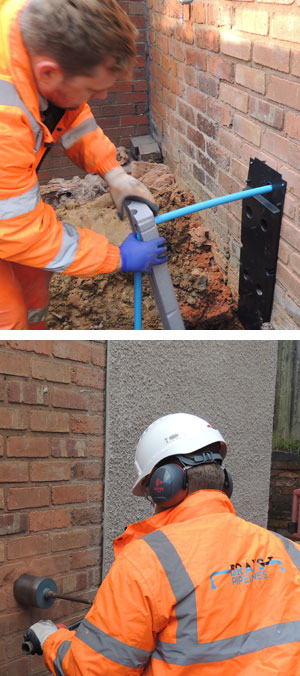Leakage and domestic consumption are the two primary strands of water conservation in the UK.
Reduce leaks, Design out joints on pipes and prepare for smarter meters
It has been calculated that 25% of water leakage is on the customer side1, i.e. service pipe leakage. Whilst this can be due to old and corroded lead supply, the majority of leaks originate from joints in the supply pipe. The House Building Federation (HBF) and Water UK have since 2014 issued best practice guidelines. Of the 5 prinicples, 4 relate to minimising use and leakage.
Meter Location Best Practice Guidelines2
1. Preferably water companies should use the Water UK/HBF Amended Contaminated Land Assessment Guidance Document for new sites and connections.
2. The use of a continuous and uninterrupted length of service pipe from the water main to the dwelling. The service pipe should be designed and constructed in such a way as to minimize the risk of leakage.
3. The Stop tap should be located above ground.
4. Water meters should be located above ground.
5. Water Companies should consider the use of technology such as ‘smart’ metering to enhance the accessibility of water consumption data for both homeowners and themselves.
An early adopter of the surface mounted meter housing is Portsmouth Water. For over 15 years they have applied a no joint policy to water supply pipes coupled with an above ground meter enclosure which probably explains their primary place at the top of the leakage charts and contributes to their high placing in the D-MeX and C-MeX league tables since 2019.
Bob Taylor, CEO Portsmouth Water explained their philosophy,
‘In the context of the Water UK Public Interest Commitment on leakage, our recent industry level reviews and our desire to build ‘leak free’ new networks have highlighted further evidence of the need to improve quality standards at the point of installation of new networks, with poor quality pipe joints often the source of future leakage.’ ‘Portsmouth Water’s policy of having a single joint free service pipe from mains connection right the way through to the wall mounted boundary box has certainly improved confidence around the longer-term quality of these new assets from a leakage perspective. This policy is also helpful in the context of reducing customer side leakage and emerging knowledge in this area is showing that this is a bigger challenge than our previous understanding indicated.’
Steve Leigh, Managing Director Groundbreaker, and developer of the wall mounted boundary box has over 40 years’ experience in the Water Industry.
‘We’ve been putting pipes in holes in the ground to protect them from frost for decades’, he explained. ‘Although it works, today’s new materials allow for a much better solution. Keeping pipes on the surface reduces the risk of leaks developing and allows for easy repair and maintenance. It’s just a must better method of working.’ Steve continued, ‘The advent of new smart metering options has also highlighted the problems of burying meters in a hole in the ground. Groundbreaker allows for a stronger communications signal strength relative to underground meter installation. Such systems have been proven to be able to be read from over 2 miles away from a single pick-up point and worldwide if linked to the internet.’
Replacing supply pipes, the quick and easy solution
Surface mounting and joint free supply does not need to be restricted to new build. Traditionally, any supply replacement program requires major excavations outside a property and causes huge disruption within. Resulting in mess and disturbance to householders over several days. This disruption has often been the cause of users’ reluctance to have the work undertaken, hence allowing leaks to persist.
Using insulated supply pipes and surface mounted boundary boxes, a new water service can be routed up the external face of the building and connected to the internal plumbing above ground level, whether this is the ground floor or upper storey. INSUduct® only requires one simple core drilled hole through the wall, at an appropriate point to connect with the internal plumbing. This enables most water supply replacements to be completed within a couple of hours, without the traditional mess and disruption to the householders or occupiers. Just as in a new supply, a no joint method of installation is used.
Reduce usage, a fit and forget solution
Water conservation is the key to reducing energy bills. Heating water accounts for nearly 1/5th of energy use in UK homes. Approximately 40% of domestic water usage is from bathroom and kitchen taps and showers. ‘Eco’ or water saving shower heads are designed to restrict the water flow to a single outlet are highly effective but retrofits like these come at a price, especially larger properties with multiple bathrooms. For households on an increasingly tight budget, or developers trying to minimise costs, multiple fittings for each tap or shower might not be an investment they are able to make. The alternative is whole site flow reduction. Fitting a device such as Groundbreaker’s NRv2 LoFlo®, at the meter regulates the level of flow entering customer premises – regardless of network pressure. As the flow of water into the premises is limited, then the amount used in ‘time controlled’ activities is also limited – but without providing a degradation of service. More importantly not requiring any intervention or behavioural change on the part of the customer, so leading to ‘natural’ reduction in consumption.

CLICK HERE for further information on the full range of Groundbreaker products
1. www.water.org.uk/wp-content/uploads/2022/03/Water_UK_A-LEAKAGE-ROUTEMAP-TO-2050_Low-Res_V3.pdf
2. www.water.org.uk/guidance/meter-location-best-practice-guidelines <http://www.water.org.uk/guidance/meter-location-best-practice-guidelines>



 ‘In the context of the Water UK Public Interest Commitment on leakage, our recent industry level reviews and our desire to build ‘leak free’ new networks have highlighted further evidence of the need to improve quality standards at the point of installation of new networks, with poor quality pipe joints often the source of future leakage.’ ‘Portsmouth Water’s policy of having a single joint free service pipe from mains connection right the way through to the wall mounted boundary box has certainly improved confidence around the longer-term quality of these new assets from a leakage perspective. This policy is also helpful in the context of reducing customer side leakage and emerging knowledge in this area is showing that this is a bigger challenge than our previous understanding indicated.’
‘In the context of the Water UK Public Interest Commitment on leakage, our recent industry level reviews and our desire to build ‘leak free’ new networks have highlighted further evidence of the need to improve quality standards at the point of installation of new networks, with poor quality pipe joints often the source of future leakage.’ ‘Portsmouth Water’s policy of having a single joint free service pipe from mains connection right the way through to the wall mounted boundary box has certainly improved confidence around the longer-term quality of these new assets from a leakage perspective. This policy is also helpful in the context of reducing customer side leakage and emerging knowledge in this area is showing that this is a bigger challenge than our previous understanding indicated.’



Leave a Reply
Want to join the discussion?Feel free to contribute!